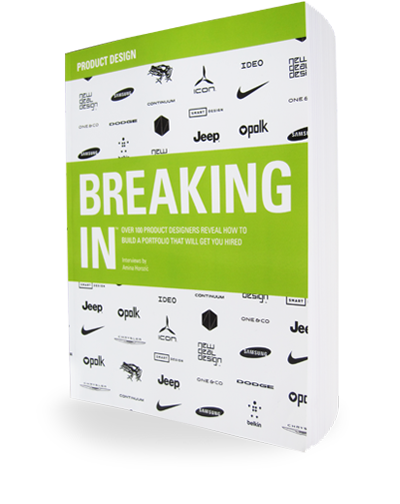Check out some great work from Blaise Bertrand.
AH: What kinds of portfolios get your attention these days, and what brings in a product designer for an interview?
BB: Generally speaking, I am looking at a number of criteria in a designer’s portfolio. First, I want to know whether or not a candidate has the “basic” industrial design tools for success: inspiration, research skills, expression tools, and, obviously, technical skills. If one does not have these fundamentals, he or she will ultimately struggle in a fast-paced, high-demand environment like IDEO. On top of these skills, I see another important dimension, which is the “magic” factor. This is the unique, unexpected quality that we can’t see anywhere else. It could be just a way of thinking, a way of expressing an idea, or even a new domain.
When we are looking for designers, we are looking for people who not only know how to answer particular design challenges in the best possible ways, but who also bring individual points of view that will help our clients move forward on their innovation journey. More and more, our clients are asking for IDEO’s perspective. Even though we formulate it during the course of a project, we also need to have people who bring a critical and personal perspective.
[ … ]
AH: How would one prepare to get a job in this changing marketplace?
BB: Students or young professionals want to have a breadth of work reflected in their portfolio. For example, their experience could go from social impact projects to consumer products. For all of them to connect, there must be a common flow, a narrative that defines the way this designer expresses himself or herself.
Furthermore, I personally love conciseness. Designers should possess the ability to synthesize complexity and to express it in an engaging way. The best candidate is someone who is able to elegantly tell a very complicated story in one sentence, one picture, one scene, or one mock-up.
[ … ]
AH: What do you expect to learn from a designer during an interview?
BB: Designers generally talk a lot about design process during an interview. It’s a legitimate conversation, but to my mind, process does not define talent. Process is a tool that students acquire in school. It teaches how to exercise a rigorous mindset to design. Once they’ve learned it, I want to see how students apply it, but also internalize it, to make it their own. The application of a process, at times, leads to expected solutions. Sticking to a particular process sometimes is the easy way, but fundamentally, it is important for students to seek the unexpected, the novelty, and to craft new paths.
[ … ]
AH: What characteristics or qualities are necessary for the designer to have in order to succeed?
BB: Talent comes first. It is a very subjective notion, but when we see a portfolio we can immediately gauge whether this person has a raw or refined talent. Usually, I never interview people alone. I interview with a diverse group of IDEO designers, varying from junior to senior. There is a sort of collective intuition and trust that guides us during an interview, which allows us to make decisions.
Curiosity is another quality. Being candid and not taking yourself too seriously—that’s also important. A sense of humor and great storytelling make a big difference.
Then there is the ability to experiment. Being fearless is important when we need to guide our clients to unexplored areas. So often I meet companies that are willing to take more risks than designers. It always surprises me. Designers need to be appropriate in their answers to challenges, but they also need to be visionaries.
[ … ]

Blaise Bertrand of IDEO

Comments are closed.